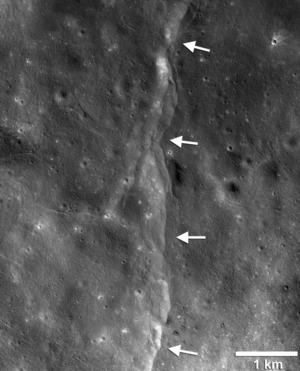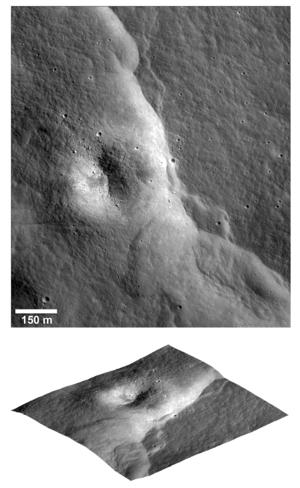Influencing Alignment Of Thousands Of Faults On The Lunar Surface
Earth's gravity has influenced the orientation of thousands of faults that form in the lunar surface as the moon shrinks, according to new results from NASA's Lunar Reconnaissance Orbiter (LRO) spacecraft.

In August, 2010, researchers using images from LRO's Narrow Angle Camera (NAC) reported the discovery of 14 cliffs known as "lobate scarps" on the moon's surface, in addition to about 70 previously known from the limited high-resolution Apollo Panoramic Camera photographs. Due largely to their random distribution across the surface, the science team concluded that the moon is shrinking.
These small faults are typically less than 6.2 miles (10 kilometers) long and only tens of yards or meters high. They are most likely formed by global contraction resulting from cooling of the moon's still hot interior. As the interior cools and portions of the liquid outer core solidify, the volume decreases; thus the moon shrinks and the solid crust buckles.
Now, after more than six years in orbit, the Lunar Reconnaissance Orbiter Camera (LROC) has imaged nearly three-fourths of the lunar surface at high resolution, allowing the discovery of over 3,000 more of these features. These globally distributed faults have emerged as the most common tectonic landform on the moon. An analysis of the orientations of these small scarps yielded a surprising result: the faults created as the moon shrinks are being influenced by an unexpected source—gravitational tidal forces from Earth.
Global contraction alone should generate an array of thrust faults with no particular pattern in the orientations of the faults, because the contracting forces have equal magnitude in all directions. "This is not what we found," says Smithsonian senior scientist Thomas Watters of the National Air and Space Museum in Washington. "There is a pattern in the orientations of the thousands of faults and it suggests something else is influencing their formation, something that's also acting on a global scale -- 'massaging' and realigning them." Watters is lead author of the paper describing this research published in the October issue of the journal Geology.

The other forces acting on the moon come not from its interior, but from Earth. These are tidal forces. When the tidal forces are superimposed on the global contraction, the combined stresses should cause predictable orientations of the fault scarps from region to region. "The agreement between the mapped fault orientations and the fault orientations predicted by the modeled tidal and contractional forces is pretty striking," says Watters.
"The discovery of so many previously undetected tectonic features as our LROC high-resolution image coverage continues to grow is truly remarkable," said Mark Robinson of Arizona State University, coauthor and LROC principal investigator. "Early on in the mission we suspected that tidal forces played a role in the formation of tectonic features, but we did not have enough coverage to make any conclusive statements. Now that we have NAC images with appropriate lighting for more than half of the moon, structural patterns are starting to come into focus."
The fault scarps are very young – so young that they are likely still actively forming today. The team's modeling shows that the peak stresses are reached when the moon is farthest from Earth in its orbit (at apogee). If the faults are still active, the occurrence of shallow moonquakes related to slip events on the faults may be most frequent when the moon is at apogee. This hypothesis can be tested with a long-lived lunar seismic network.
"With LRO we've been able to study the moon globally in detail not yet possible with any other body in the solar system beyond Earth, and the LRO data set enables us to tease out subtle but important processes that would otherwise remain hidden," said John Keller, LRO Project Scientist at NASA's Goddard Space Flight Center, Greenbelt, Maryland.
(Images provided by NASA. Top: Thousands of young, lobate thrust fault scarps have been revealed in Reconnaissance Orbiter Camera images (LROC). Lobate scarps like the one shown here are like stair-steps in the landscape formed when crustal materials are pushed together, break and are thrust upward along a fault forming a cliff. Bottom: A nadir (top) and perspective view (bottom) of a prominent lobate fault scarp in the Vitello Cluster, one of thousands discovered in Lunar Reconnaissance Orbiter Camera images (LROC). In the perspective view, the Narrow Angle Camera (NAC) image is draped over topography derived from NAC stereo images.)
 ANN's Daily Aero-Term (04.25.24): Airport Rotating Beacon
ANN's Daily Aero-Term (04.25.24): Airport Rotating Beacon ANN's Daily Aero-Linx (04.25.24)
ANN's Daily Aero-Linx (04.25.24) Klyde Morris (04.22.24)
Klyde Morris (04.22.24) Airborne 04.24.24: INTEGRAL E, Elixir USA, M700 RVSM
Airborne 04.24.24: INTEGRAL E, Elixir USA, M700 RVSM Airborne 04.22.24: Rotor X Worsens, Airport Fees 4 FNB?, USMC Drone Pilot
Airborne 04.22.24: Rotor X Worsens, Airport Fees 4 FNB?, USMC Drone Pilot




